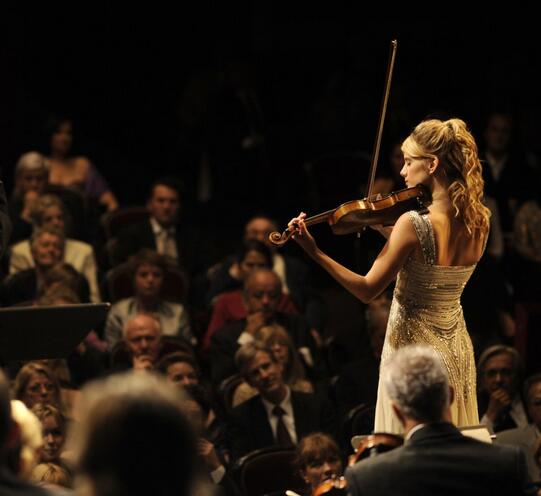So what can be done to distribute the sound evenly in every direction?
把聲音向所有方向傳播出去,要怎么辦呢?
The answer is: avoid straight, parallel walls. Karen?
答案是:不要用直立平行的墻壁。凱倫?
But I think I've seen photos of rectangular concert halls.
我覺得我見過長方體形狀的音樂廳。
Right. Older concert halls from the 1800s are generally rectangular.
對。1800年左右的老式音樂廳基本上都是長方體形狀的。

But they all have a lot of decorations on the walls inside, lots of ornamental plasterwork like statues, which distribute sound very efficiently, reflecting it in all different directions.
但這些音樂廳的內墻都有很多裝飾,很多水泥裝飾物,比如雕像,這些裝飾物能有效傳播聲音,朝不同方向反射。
And that brings me to another variable we need to consider - the acoustic characteristics of the building materials as well as the wall and floor coverings.
這就引到了另一個我們需要考慮的變量——建筑材料和鋪地材料的聲學性質。
In fact, most objects you see in a concert hall or theater serve double duty.
事實上,大部分你在音樂廳或劇院看到的東西都有雙重功能。
The plush chairs absorb sound and soften reverberation.
絨面座椅能吸收聲音,弱化回聲。
And the beautiful crystal Chandeliers?
漂亮的水晶燈?
They are very good at diffusing sound.
它們用來擴散聲音非常有用。
You see, everything must be planned down to the last detail in order to predict the acoustic performance of a room.
為了預測房間的音響效果,所有的東西都要考慮到細節(jié)。
That being said, there's something that can't be controlled by the architect.
那就是說,有些東西是建筑師無法掌控的。
The audience has an effect on acoustics too.
觀眾本身也有聲學影響。
The heads of people are good diffusers of sound.
人的頭部也能很好地漫射聲音。
And architects try to account for this effect in their design, but they can't guarantee a full auditorium.
建筑師嘗試在設計中考慮這一因素,但他們也不能保證禮堂是座無虛席的。










